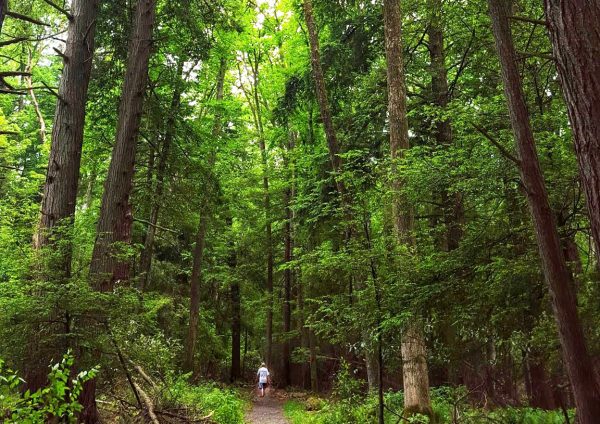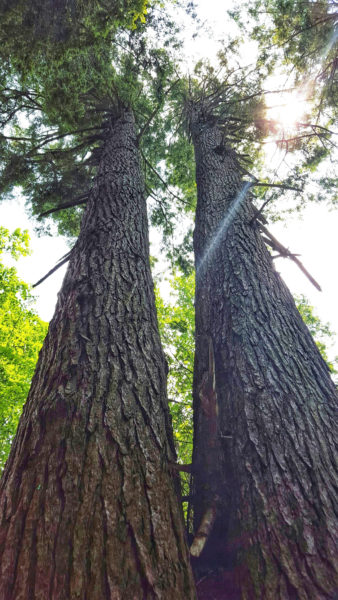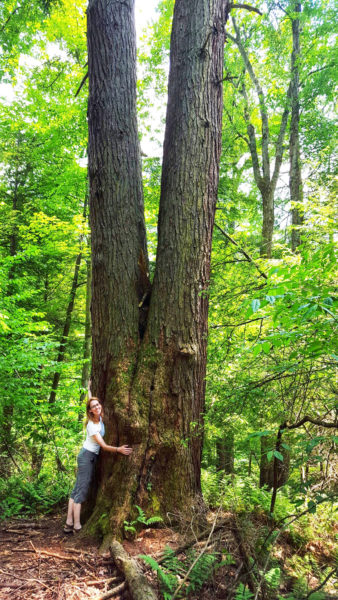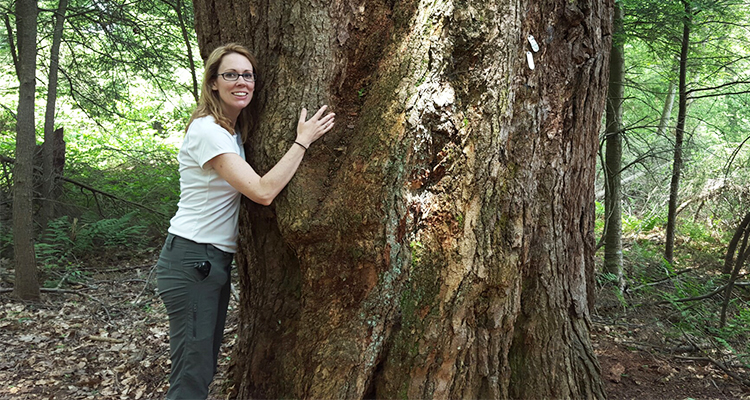Just down the road from Deep Creek Lake, Md., sits one of my favorite West Virginia day trips, Cathedral State Park. It’s another spot I’ve recently discovered. As we traveled to and from Canaan Valley and Blackwater Falls State Parks for years, I had no idea it lay nestled in a quiet corner of Preston County.
About the Park
Cathedral’s 133 acres don’t occupy much space, and this is a shame because it’s the only stand of virgin eastern hemlock left in the state of West Virginia. Hemlock is one of my favorite trees; you find them in damp places in our region (they grow at Swallow Falls State Park, though the biggest of the bunch came down during Hurricane Sandy’s heavy snowfall in 2012). Hemlocks get big, and they smell like West Virginia mountains. Or, rather, West Virginia mountains smell like hemlock. It’s my favorite scent in the world.
The last of our hemlock giants live in Cathedral State Park, and there aren’t a whole lot of them remaining. Those you will meet sprouted in America long before it was America, 400 years ago. They’ve grown to 90 feet in height and 20 feet in circumference. And if I may say so, they’re incredibly huggable. (If you make it to 400 years old, I promise we’ll all hug you, too.) In addition to the eastern hemlocks, you’ll find 170 other species of ferns, trees and wildflowers.
Cathedral is small, but it feels ancient and wild. Nevertheless, the park began as Brookside Resort in 1882. Visitors trekked from Baltimore and D.C. to escape city life. In 1922, the caretaker of the resort purchased the land and sold it to the state with the condition that it remain an uncut forest. In 1966, Cathedral was added to the National Registry of Natural Landmarks.
The name fits the park. There’s something holy about this forest, something spiritual. After all, these trees have seen things we can’t fathom.

Things to Do
People drive to Cathedral to see the trees. It’s a day park only; there’s no camping, but the Maryland state parks and Blackwater Falls are a short drive up and down Route 219, respectively, for those looking to spend the night. Hikers can walk over five miles of trails, all of which loop around and across one another. You’ll have plenty of hiking choices to fit your schedule, as there are six trails in total. The park’s website indicates geocaching activity, and picnickers can take advantage of two shelters, a playground and restrooms.
Why You Should Go Now
I dislike having to write this section, but there’s always an environmental threat to our favorite places, and Cathedral is no different. If you want to see the last virgin tract of eastern hemlock — behemoths that dwarfed your ancestors’ ancestors — you’d better do it soon. The hemlock woolly adelgid, an East Asian exotic pest wreaking havoc on the trees, was recently discovered within 20 miles of Cathedral State Park. The insect, which arrived in the U.S. in the early 1950s, sucks the sap from hemlocks. In its native Japan, the adelgid is kept in check by predators, but here it runs amok. The adelgid currently inhabits a large swath of the east from Georgia to Maine and up into Nova Scotia. Ninety percent of the eastern hemlock’s geographic range has been affected by this destructive exotic. Once infested, the tree can’t produce new growth and dies within four to 10 years.

Things look bleak for the eastern hemlocks, but biologists are experimenting with biological control. They’ve brought a black lady beetle, the adelgid’s natural predator, from Japan, and the beetles are doing their jobs. The trees can also be treated with insecticide, provided that the treatment is kept out of the water. Still, the woolly adelgid reproduces rapidly, and the trees are losing the battle.
As with all elements of our ecosystem, the hemlock plays an important role. Hemlocks prevent erosion along streams, offer food for wildlife and provide lumber. When the hemlock canopy dies, the understory of the forest — the lower levels — is suddenly exposed to light. Amphibians that prefer the cool, dark and dampness of a hemlock forest, like salamanders and newts, as well as nesting birds, can’t tolerate the habitat change. Also, the brook trout — West Virginia’s state fish — requires cool, shady streams.
Without the trees, we lose the fish. Without the fish, we can’t go fishing. That means you spend the weekend cleaning out the garage instead, and you’ve been putting that off for 17 years. The adelgid is bad news.
If you’ve been skimming this article for the major points, here’s the biggest one: eastern hemlock trees are losing the battle against the woolly adelgid. Go now. See them.
What I Brought
I wore hiking sandals this time, and I wished I’d had closed-toed shoes. It’s mucky. Not excessively so, but while the hikes are relatively flat, the ground is soft and damp. You’ll step over soggy places, and you’ll also want to step off the trail to see Rhine Creek, which runs through the forest. Flip-flops will trip you; stick with decent shoes. Also, if you’re a little unsteady, stabilize yourself with a hiking stick.
You probably don’t need sunscreen under the canopy, but bug spray can be helpful. I visited in June, and no blood-sucking insects accosted me, but bring repellant anyway. As usual, beware ticks.
Other hiking staples include water and a camera. You’ll find restroom facilities and a park ranger, too. Good signage marks parking and trails. Silence blankets the paths, as the deep forest blocks out the sounds of nearby Route 50.
Children will enjoy Cathedral. It takes about one hour to walk the longest trail. The park welcomes leashed dogs. If you’re short on time or just need a break from the confines of your vehicle, check out Wood Thrush Trail or Giant Hemlock Trail. The park is open year-round and really shines after a snowfall.
Where and How to Find
Cathedral is a great stop when you’re visiting other West Virginia state parks. If you read about Cranesville Swamp in my last one-tank trip piece, know that you can do both in the same day. It’s an easy drive from Deep Creek and Swallow Falls state parks (where eateries abound). In other directions, you can travel from Cathedral to Tygart Lake and Valley Falls state parks.
Cathedral sits about two hours and 20 minutes from Wheeling. The quickest way to get to there is to take I-70 east, then I-79 south to Morgantown, then take exit 148 for I-68 east toward Cumberland. Take exit 1 for US 119 south for 7.4 miles. Turn left onto Gladesville Road and stay on that road. Turn right onto WV 92 south and left onto US 50 east for 23 miles until you reach the park.

Alternatively, if you’re heading toward Canaan Valley via Deep Creek on Route 219 south, Cathedral State Park isn’t far out of your way. We live in a technological age, so I’ll spare you the directions. You’ll find it.
Go Ahead and Hug Them
People call me a tree-hugger, sometimes as a compliment and sometimes as an insult. I respond the same way: Thank you. I’m damn proud to be “that person” in the forest with my arms around the trunk of an ancient hemlock. When I was young and easily embarrassed, my father used to ask me to hug giant virgin oaks in Dysart Woods for photographs. I thought it was goofy. Now, I ask my own kids to do it. In all honesty, though it sounds cliché, the hug you give a hemlock may be its last. In the fall of 2014, lightning toppled West Virginia’s largest hemlock at Cathedral. From an observation deck, you can check out the 20-foot stump as it breaks down and turns to soil. It’s hard not to be sad, but this is how nature does it. There’s no emotion. Just efficiency.
Final Thoughts
It took 400 years for that fallen tree to reach its full potential, and now it’s returning to the earth. Last year, the famous sequoia that tourists once drove their cars through in Sequoia National Park came down. I haven’t seen the sequoias yet, but it’s on my list of places to visit. I’m too late, though, for that one phenomenal tree. I never got to hug it.
You don’t have to get emotional about Cathedral the way I do, and you certainly don’t have to put your arms around the trees. To me, it’s both a symbolic gesture and, in another way, a very real hug. I love eastern hemlocks. They speak to who I am as a West Virginian. These trees mark our place in this country — we come from the eastern hemlock forest. We come from mountains and streams. We come from shade and stone and deep, quiet places. I am honored to stand in the presence of such beings, to be a part of lives that have known native peoples and immigrants, wars and technological advances. They aren’t just trees; Cathedral State Park is a holy temple. They won’t be here forever. I wish for you all a moment in their shadows.
Now get out there.
• Laura Jackson Roberts is an environmental writer and humorist in Wheeling, W.Va. She holds an MFA in Creative Writing from Chatham University. Her work has recently appeared in Brain, Child Magazine, Vandaleer, Animal, Matador Network, Defenestration, The Higgs Weldon and the Erma Bombeck humor site. Laura is the Northern Panhandle representative for West Virginia Writers and a member of Ohio Valley Writers. She lets her kids play with sharp objects, hates earwigs and has unusually small feet. Visit her online at www.laurajacksonroberts.com.


